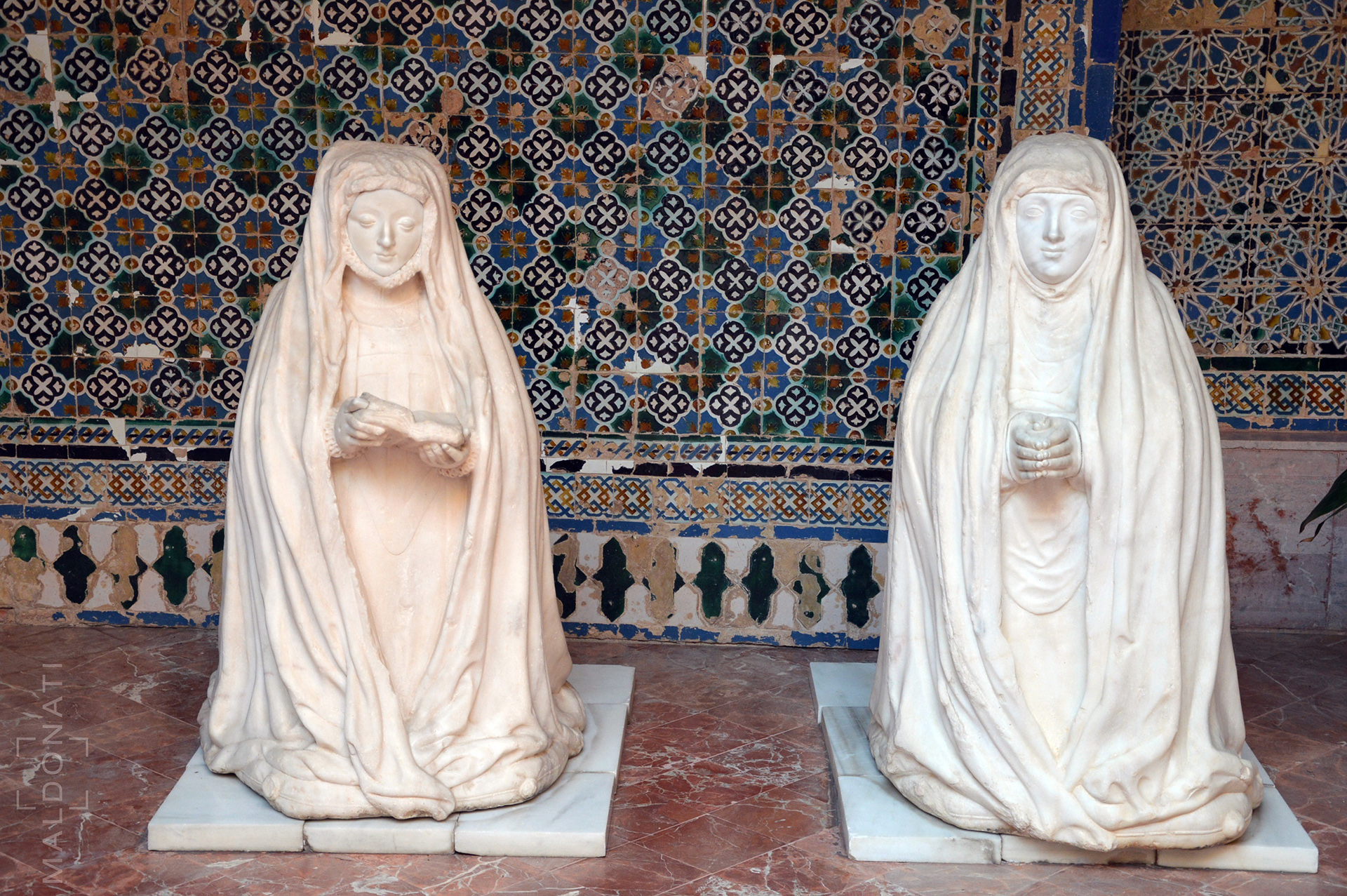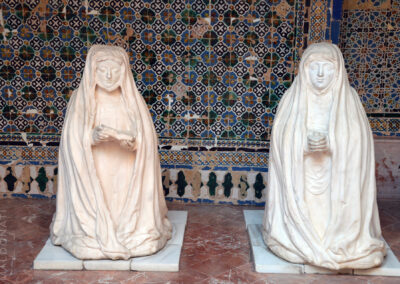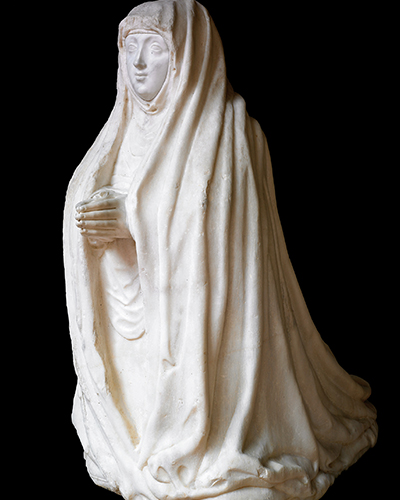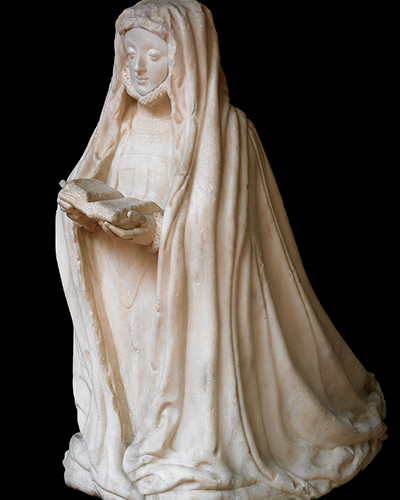On 15 November 1570, the widow of Hernán Cortés, Juana de Zúñiga, had signed with the Dominican convent of Madre de Dios in Seville some capitulations by which she handed over 5,500 ducats for the construction and altarpiece of the church and 20,000 maravedís of annual income for its maintenance, and in exchange, she received the patronage of the main chapel of her church and the exclusive right of burial in the vault carved underneath it. One of its clauses established that the widowed Marquise del Valle de Oaxaca could place "...".in the said main chapel in the middle of the said chapel, the packages that the said lady Marquise wishes, which must be of marble or alabaster or as her ladyship sees fit, with their iron grilles around the packages, placing on the said grille and on the said vault the letters and arms of çúñiga and courtesans.". By virtue of it, his son-in-law, Fernando Enríquez de Ribera, II Duke of Alcalá, on 25 September 1575, signed a contract with Diego de Pesquera by which the sculptor was obliged to "facer [...] two figures of clean and very good white otranto marble [...the one representing the lady doña juana de çuñiga marquise of the valley and the other the very illustrious lady catalina her daughter that god has and they should be anbas yncadas of knees on some coxins and the lady marquise to destar in abito of biuda e a de tener las manos puestas y delante un sitial con un libro encima abierto y la señora doña catalina a destar en abito de abito de donzella y a de tener un libro abierto en las manos y an de estar cubiertas con sus mantos por encima de la cabezaça"(Celestino López, 1929).
The contract stipulated that the sculptor was obliged to make life-size models in clay, which were to be approved by the Duke of Alcalá, and that the work, valued at 600 ducats, was to be paid for in thirds, the last third to be left for completion. From both obligations it can only be inferred that they were completed to the full satisfaction of their promoter and that, if they were not finished within the stipulated eight months, they must have been completed before Pesquera left Seville for good in 1580.
Until now it has been maintained that these praying sculptures were never in the convent chapel or, at best, were immediately replaced by other recumbent ones - those that currently occupy the austere lateral arcosolios of the Capilla Mayor - which the Duke of Alcalá himself arranged, by contract of 13 April 1589, with the sculptors Juan de Oviedo and Miguel de Adán (Celestino López 1929), and those of Pesquera moved to the Jardín Grande de la Casa de Pilatos, as they appear in an inventory of 1751, which states that " [....] old memoirs say that they were in the monastery of the nuns of Madre de Dios.". It seems more reasonable to think that the sculptures by Oviedo and Adán were commissioned to complement the existing ones, perhaps to accentuate the character of the convent's main chapel as a family pantheon, and not just a personal one, months after the body of the 2nd Duchess of Alcalá de los Gazules, who died on 27 May 1588, had been placed in its vault, and a few years after that of the 2nd Marquise of Valle de Oaxaca, Ana Ramírez de Arellano, had been placed in the vault. The different nature of the latter contract, whereby the sculptors were not obliged to represent a specific person, but only to carve "...", would add to this idea.two figures lying on a bed [...that] they must wear the clothes and clothing requested by the master builder and Dr. Herrera on his behalf."The packages were not to be of a single piece, but of several fragments of marble that were to be delivered to him, and the work was estimated at a quarter of the value of the previous one, 150 ducats.
Pesquera's sepulchral work has come down to us mutilated, as the contract also obliged to make a ".bed"The same marble with heraldic ornaments, pieces that have disappeared together with the seat that the Marquise of the Valley must have had before her, and to carve ".two coats of arms of çuñigas and courtesans of one and a half rods"originally intended to decorate "the high sides of the said chapel"These are probably the ones currently placed at the back of the arcosoliums in inverse correspondence with the recumbent statues, if they were intended to represent the Marquise del Valle and her daughter respectively. The present sculptures are also incomplete, lacking the ".the tarja and sign with two children holding it"mentioned in the contract. This last element leads us to think that they were not conceived for their current form, exposed in an arcosolium, but, as foreseen in the chapters signed with the Dominican community in 1570, as free-standing tumuli in the middle of the chapel, like the praying sculptures, all protected by grilles with the arms of Zúñigas and Corteses. The most plausible scenario is that, in the extensive reform of the presbytery at the beginning of the 18th century, the burials, as has happened with almost all the tomb monuments, were moved to the current arcosoliums and that, in this operation, the orantes were left over, as were the basins held by children that the recumbents would have had at their feet.
In any case, the many years that they were exposed to the elements in the garden of the Casa de Pilatos took their toll on their state of conservation - as early as 1751 they were described as "...".abused"In the 1960s they were restored by the Cadiz sculptor Juan Luis Vassallo, who recomposed their faces, and moved to the antechapel of the palace, from where, in 1992, they were taken to their current location in the courtyard of the chapter house of the Charterhouse of Santa María de las Cuevas.
In 2024 the Factum Art Foundation produced life-size reproductions for "return them to"These replicas, together with two facsimiles of the deeds. These replicas, together with two facsimiles of the deeds, which, among the documentation of the convent of Madre de Dios, are in the Medinaceli Archive, relating to the right of burial and the patronage that the house of Alcalá de los Gazules exercised over the main chapel of its church, were presented to the Dominican community in a ceremony held in the convent chapel on 19 March 2024. This text is a recapitulation of the explanation given by the director general of the Fundación Casa Ducal de Medinaceli on the history of these pieces.




